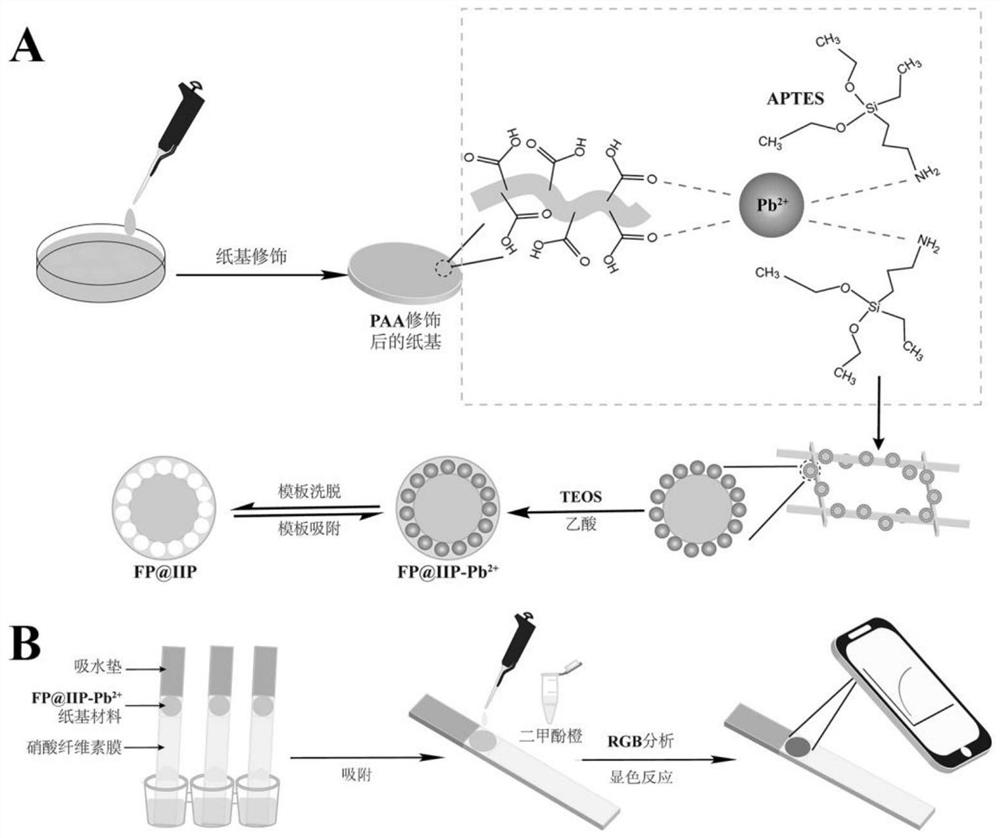Paper-based test paper for rapidly detecting lead in tea leaves by applying ion imprinting color development
An ion imprinting, paper-based technology, applied in the direction of chemical reaction of materials, material analysis by observing the influence of chemical indicators, etc., can solve the problems of cumbersome operation, long time consumption, etc. stable effect
- Summary
- Abstract
- Description
- Claims
- Application Information
AI Technical Summary
Problems solved by technology
Method used
Image
Examples
Embodiment 1
[0042] according to Figure 1-Figure 6 The present invention provides a paper-based test paper for rapid detection of lead in tea leaves by using ion imprinting color development, including a paper base and a lead ion imprinted film constructed on the surface of the paper base, and the lead ion imprinted film is formed on paper by a sol-gel method. The paper-based substrate includes neutral filter paper, PVC membrane, Whatman filter paper or nitrocellulose membrane, and the surface of the paper-based substrate can allow the solution to pass quickly to the enrichment area.
[0043] The base material of the lead ion imprinted membrane is natural cellulose. The natural cellulose material is quantitative filter paper, soft facial tissue or cloth, and the natural cellulose is formed by interweaving many microfibers and nanometer-level fiber nets.
[0044] Wherein, comprise the preparation method of this paper-based test paper, concrete steps are as follows:
[0045] S1. Paper bas...
Embodiment 2
[0053] The paper-based test paper is FP@IIP-Pb 2+ Paper-based imprinting material, its preparation method comprises the steps:
[0054] (1) prepare 10mL hydrochloric acid, the concentration is 0.2M, soak filter paper in hydrochloric acid and clean, take out and wash with ultrapure water until neutral, dry, obtain the filter paper after cleaning;
[0055] (2) Immerse the cleaned filter paper in the PAA aqueous solution, and after ultrasonication for 30 minutes, take it out, wash it with ultrapure water, and dry it to obtain a PAA-modified paper base;
[0056] (3) Configure 0.01mol / L-0.02mol / L lead nitrate, the solvent is ethanol aqueous solution (ethanol: water = 4:3-1:1, v / v), add acetic acid and APTES, after mixing, put in 60 ℃ for pre-polymerization;
[0057] (4) After the pre-polymerization, add TEOS to the pre-polymerization liquid, after half an hour of ultrasonication, add the PAA-modified paper base, and carry out formal polymerization reaction at 60°C;
[0058] (5) ...
Embodiment 3
[0067] When the paper-based test paper can rapidly detect the lead content in tea leaves by ion imprinting color development method:
[0068] First, assemble the test paper for rapid detection of lead in tea by color development of ion imprinted paper: on the back plate of 4.5cm*0.6cm, the front end is pasted with 2.5cm*0.6cm nitrocellulose membrane (as the sample loading channel), and the back end is glued An absorbent pad is attached to provide driving force for sample loading. Finally, paste FP@IIP-Pb in the middle 2+ Paper-based imprinting materials, assembled to obtain a paper-based platform integrating sample loading and adsorption;
[0069]Pretreatment of tea samples: Accurately weigh 2g of pulverized tea samples, fully carbonize them on an electric furnace, ash them in a muffle furnace at 500°C for six hours, take them out and cool them, add 4mL of 10% hydrochloric acid, evaporate to dryness and set The volume was reduced to 5mL to obtain the sample extract. Mix 1 m...
PUM
 Login to View More
Login to View More Abstract
Description
Claims
Application Information
 Login to View More
Login to View More - R&D
- Intellectual Property
- Life Sciences
- Materials
- Tech Scout
- Unparalleled Data Quality
- Higher Quality Content
- 60% Fewer Hallucinations
Browse by: Latest US Patents, China's latest patents, Technical Efficacy Thesaurus, Application Domain, Technology Topic, Popular Technical Reports.
© 2025 PatSnap. All rights reserved.Legal|Privacy policy|Modern Slavery Act Transparency Statement|Sitemap|About US| Contact US: help@patsnap.com



